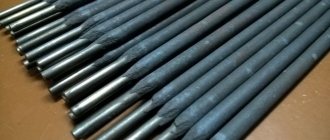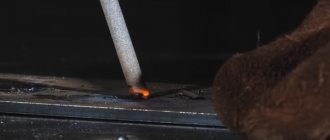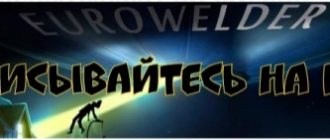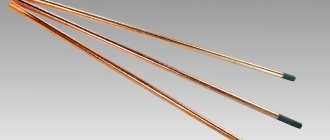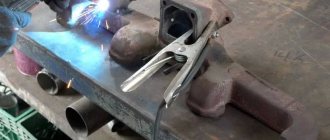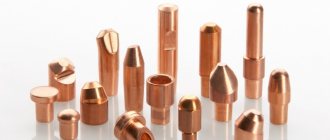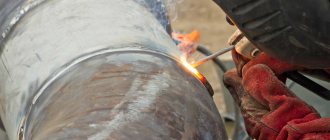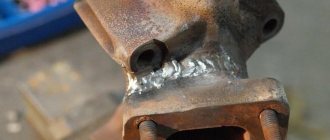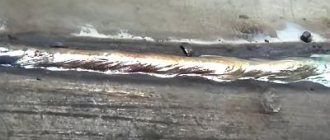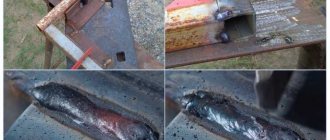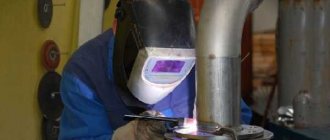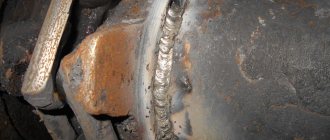To connect parts made of cast iron of various grades, cast iron electrodes are used, and the marking of products indicates their composition and purpose. The choice is related to the welding technology and the brand of material being welded.
Cast iron is an alloy of the elements iron and carbon with alloying additives (nickel, chromium, vanadium, magnesium) to form the necessary physical and mechanical properties. It contains a high percentage of carbon (over 2%), which makes it hard and brittle, but makes weldability difficult.
The process is accompanied by increased gas formation, which leads to porosity and heterogeneity of the seam. Uneven heating causes cracks to appear, and due to oxidation, uncooked zones remain. It has been noticed that thermal exposure leads to spreading of the metal, which makes it difficult to form a seam.
Specifics of processing cast iron products
The material in question contains more than 2% carbon in its composition, which is why it becomes both hard and brittle. This makes it difficult to process. The selected “consumables” must compensate for a number of negative qualities of the material arising from the physical and chemical properties.
To connect each type of material, cast iron electrodes with a certain ratio of chemical elements are selected, as well as a heat treatment method. Tig welding is considered to be of the highest quality, but it is very expensive. Electrodes are used both in enterprises and in everyday life.
The main requirement for products is that the cooling time coincides with the metal being welded, and for cast iron it is quite long. The second is the same concentration of carbon in the base and filler material. A wise choice will help to avoid overvoltage inside the workpiece or carbon burnout.
Electrodes for cast iron are thicker than their counterparts for steel, since the material is very massive. It serves as the basis for bulky structures. Most have a basic coating (less sour); this expands the scope of use of consumables. Production, labeling, and chemical characteristics of electrodes are regulated by GOST 7293-85.
Important Tips
It must be remembered that electrodes for steel workpieces are not suitable for welding cast iron due to other physical properties and structure of the material. Residual stresses and fatigue phenomena can cause destruction of the weld during further operation. Electrodes for cast iron are much thicker than consumables for steel, which is determined by the massiveness of the material.
The electrodes used must correspond to the cooling time with the base metal, which is very long for cast iron. The percentage of carbon content in cast iron and filler material must be the same. Compliance with the basic conditions will help avoid carbon burnout and the occurrence of excessive internal stress.
More often, rods with a basic type of coating are used. Acid spraying is less common.
Cast iron welding methods
There are two of them:
- hot;
- cold.
The first method requires two conditions to be met:
- preheating the workpiece up to 500 degrees (+/- 200 degrees);
- using flux-cored wire with an additive.
Heating is a short-term action carried out by current. The material cools evenly, within 70-100 hours. Cast iron electrodes with a diameter of about 10 mm, used when welding with currents from 600 A to 1 kA, are suitable here.
Cold welding is a more popular method of joining parts, classified by the type of electrode used (steel, nickel, etc.). It differs from hot by lengthy preparatory work, including stripping, milling and drilling in order to give it maximum cleanliness and smoothness.
How to use UONI electrodes on cast iron
In some circumstances, you can work with cast iron using copper-steel electrodes. They are made by winding a spiral of copper, sometimes brass wire, 1.5-2 millimeters thick, onto UONI 13/45 steel intended for welding. Its weight should exceed five times the mass of the metal rod of the electrode. If it is necessary to hot weld parts made of cast iron, SSSI can be used.
Good results are obtained using UONI-13/55. But when using them, it is important to take into account the fact that you do not need to allow the part to become too hot. This leads to the appearance of cracks at the point of thermal influence. Therefore, the welder needs to ensure that the product does not overheat, and this happens already at +400 +500 degrees Celsius. It is also important to ensure that the metal does not heat up at a distance of more than 100 millimeters from the seam.
Types of products
Welding experts advise using electrodes made from steel, iron, nickel or alloys containing these elements. The following types of consumables are suitable specifically for cast iron:
- steel;
- nickel;
- copper-nickel;
- ferro-nickel;
- copper-iron.
Steel electrodes are used when processing old surfaces that have already been exposed to extreme temperatures. This also applies to cast iron of poor quality or contaminated with metals and slags, such as the designs of industrial furnaces or, for example, pumps. Preparatory work is required (surface cleaning described above).
Cast iron, which contains graphite, is welded using bimetallic electrodes. These materials, like their malleable counterpart, are easily alloyed using ferro-nickel electrodes.
OZCH-2
The key area of application of this range of electrodes is the elimination of casting defects in cast products, as well as the application of a number of layers in components and interfaces using the cold method. Applicable to products made from various types of cast iron.
Experienced welders recommend making a weld on the lower or vertical plane. Reverse polarity of direct current contributes to achieving high quality welding. Such technological parameters are best combined with OZCh-2. A distinctive feature of OZCH-2 is the impeccable welding of parts and components of mechanisms and piece components of the finished product, which have insignificant wall thickness and sections in the perpendicular axis.
A few words about labeling
The name of the products, established by GOST, will provide information about the elements that form the electrode. Although iron is the main element for most brands, others are often found. If you consider the popular brand MNC-2, you will find the following chemical elements (with quantities for a given electrode):
- copper (M) - here about 30%;
- nickel (N) - about 65%;
- Ch - intended strictly for cast iron products;
- 2 - the serial number of the electrodes of this series, indicating the ratio of elements (they occur with the same composition, but a different quantity).
Now we invite the reader to familiarize himself with the most famous models for joining cast iron.
OZCH-4
Used in technological operations when welding with most grades of cast iron. Cold welding, surfacing, straightening of castings made of high-strength cast iron with nodular graphite are operations that do not create additional costs of time, resources and energy.
If the place of the weld during further operation will be subject to impacts, friction against cast iron or other metal, be sure to use OZCH-4. Cutting and surface grinding also require the use of such electrodes. There are castings and products that have high quality requirements for surface cleanliness. Thanks to the above-mentioned features of the seam obtained using OZCH-4, such properties are achieved at large production volumes.
Welding modes and welding technique are similar to OZCh-2
Popular electrodes
Below is a list of brands that are in demand among amateurs and professionals.
- MNCh-2 and OZCh-4
Universal consumables suitable for all cast irons. Allows you to weld parts in any position (OZCH-4 - except half-ceiling). In addition to joining, they are applicable when welding defects or surfacing. To normalize operation, a constant reverse polarity current is used.
- OZCH-2
It differs from the previously named one in its narrow scope of application - for gray and ductile cast iron. The workpieces are not heated; the permissible working positions are all except for the semi-ceiling position.
- OK-92.18
Suitable for hot welding. Unlike those mentioned earlier, alternating current is also used in processing.
- TsCh-4
Universal electrodes for welding cast iron using both methods. A narrow range of use (strictly lower position), welding with direct current of reverse polarity (at higher voltages, alternating current is used), the ability to connect cast iron with certain grades of steel - this is the specificity of the TsCh-4.
- OZZHN-1
For cold working of gray and ductile cast irons. Moderate consumption of elements allows you to perform voluminous work.
In addition to the six products described above, when selecting electrodes for processing cast iron, it is recommended to pay attention to such foreign manufacturers as UTP and ASPIK. Any manufacturer offers its own method of welding the material by introducing new elements into the composition and changing the concentration of key ones. In each case, the user needs to know the type of cast iron being processed and its thickness in order to select the correct consumables. More on other principles for selecting electrodes below.
The main difficulties when welding cast iron
What electrodes are used for underwater welding
Cast iron has much greater fluidity than steel, so it is recommended to cook various cast iron products at home only in the lower position. If cast iron is overheated during welding, this will lead to the formation of large pores and stress in the weld. Therefore, it is not recommended to overheat cast iron and subject it to rapid cooling.
The main defects when welding cast iron are associated precisely with uneven heating and cooling of the welded products. The appearance of cracks in this case is the most difficult defect, which is very difficult to get rid of in the future.
In addition, when welding cast iron, it is very important to properly prepare the materials.
Preparing cast iron for welding
To obtain a high-quality welded joint, the surface of the cast iron is properly prepared before welding. Firstly, it must be cleaned of any contaminants, and then degreased, for example, with acetone or solvent.
If it is necessary to cook thin cast iron, then it is imperative to provide special heat-dissipating pads for welding points. A prerequisite for welding cast iron is the cutting of product edges. For these purposes, even before welding, their edges are processed with a file or an angle grinder with a metal disc.
In the case when it is necessary to weld a crack in cast iron, it must be drilled along the edges, after which, as with the edges, it is cut along its entire length. Some welders cut out the cracks first and then drill out the edges to prevent them from spreading further.
Depending on the chosen method of welding cast iron, and there are only three of them (hot, semi-hot and cold method), heating of the product is required. Let's take a closer look at the technological process of welding cast iron products at home.
Methods of welding cast iron
There are three ways to weld cast iron:
Hot method - requires heating cast iron products before joining to a temperature of at least 600°C.
The semi-hot method is not much different from the hot method of welding cast iron, with the exception of the temperature, which is almost half lower (300-350°C).
Cold method - carried out using a piece electrode without preheating the cast iron workpieces. Welding cast iron at home is carried out using this joining method.
Nuances of choice
Compliance of the product with the brand of material being welded is the main purchase criterion.
It is advisable to select products with a special rod material for a specific type of cast iron, regardless of the availability of universal brands. It is also worth taking a closer look at the coating (external treatment). Basic and acidic coatings react differently to certain operating conditions, which is important to remember. If you are going to deposit electrodes on a workpiece, the thickness of this coating plays an important role. Prefer the thickest models for working with old, poor quality or contaminated cast iron.
When welding thin-walled cast iron, the electrodes are selected so that their thickness and the workpiece itself match or are as close as possible. Otherwise, either sticking or melting of the part will occur, which will worsen its appearance and will not allow achieving the required result.
The correct choice of electrodes for welding cast iron is the key to successful, fast, efficient work. If you have to weld this difficult material for the first time, do not bother choosing - use products of the MNCh-2, TsCh-4 or OZCH brands of series 2, 3, 4. Their thickness varies from 3 to 6 mm, which allows you to get a high-quality seam. If you want to choose high-quality foreign-made consumables, universal UTP brand products are recommended.
What, in your opinion, can be added to the list of good electrodes for cast iron? Share your opinion in the comments.
Marking of electrodes on cast iron
The marking of electrodes for cast iron indicates what they are made of, what they are intended for, and the series number. For example, let's decipher MNC-2 .
- M - means that there is copper in the electrode,
- N - indicates the nickel content in it.
- H – shows what type of metal the electrode is intended for.
- Number 2 is the brand number; other similar products are produced in this series, but with a different composition.
Some markings may contain other details. E46-LEZS-UD-E431(3) RC13. E46 is a type that means that the electrode has a temporary tensile strength of 46 kilograms per square millimeter. The brand abbreviates the manufacturer. Attention is also paid to the diameter. UD – stands for: for welding products made of carbon and low-alloy steel, it has a thick coating. RC - means that it is rutile-cellulose.
Electrodes for welding cast iron manifold
To successfully carry out welding work on a cast iron manifold, it is recommended to buy the TsCh-4 brand. These electrodes are produced in thicknesses of 3-5 millimeters. They need to work when placing parts in the lower spatial position, setting 65-80 amperes, 90-120, 130-150, these current indicators depend on the diameter of the electrodes, respectively. Before use, it is better to ignite them for two hours at +170 +200 degrees.
MNCh-2 is suitable for welding any cast iron parts. The resulting seam is perfectly processed. Electrodes for the collector are selected depending on the type of cast iron . It comes in regular, malleable, gray, and other varieties. The metal of the rod is selected for the composition of the collector. There are electrodes suitable for any type. This could be MNC-2. The type of coating and thickness are also taken into account.
Types and properties
The main characteristic is the material of manufacture. Manufacturers use the following metals:
- Steel;
- Cast iron;
- Copper.
At the same time, if steel and copper products are in the form of wire, then cast iron is produced in the form of rods of various lengths.
The steel rods are coated with a thin layer of ferroalloys, which gives the seam a gray tint. Such electrodes are able to work with any welding machine, which is the reason for their popularity among home craftsmen.
Preparation for welding
Electrodes for cast iron can be used by professionals and home craftsmen. In any case, preliminary preparation of products for this process is necessary. It consists of cleaning the joined surfaces from dirt, rust, grease stains and paint. It is also necessary to remove the oxide film.
The welded edges must be ground. If there are cracks, irregularities, or chips on the surfaces, there is a danger that during the welding process the molten mass will begin to flow out of these cracks and other defects.
The most significant part of the preliminary preparation when using cast iron electrodes is warming up the workpieces before starting welding. Cast iron begins to melt at a fairly low temperature, reaching 1200-1250 degrees. It follows from this that preheating of products should not exceed 500-700 degrees. It is necessary to warm up not only the place of the future connection, but also a small area around it. Such actions will minimize the likelihood of cast iron cracking.
If welding is carried out in an industrial environment, then special crucibles are used for preheating. When work is carried out at home, you can use a gas burner and carry out the work in the garage.
OK 92.18
The new name for these electrodes is OK Ni-Cl. They have a base coating with a high graphite content. Designed for welding with minimal heating. They operate on both direct and alternating (at the same time reduced) currents. They have proven themselves well in the repair of products made from thin parts (welding damage and defects in gearboxes, pump housings, engine blocks, etc.). Answering the question of which electrodes are suitable for welding cast iron and steel, we note that along with TsCh-4 these are also suitable.
